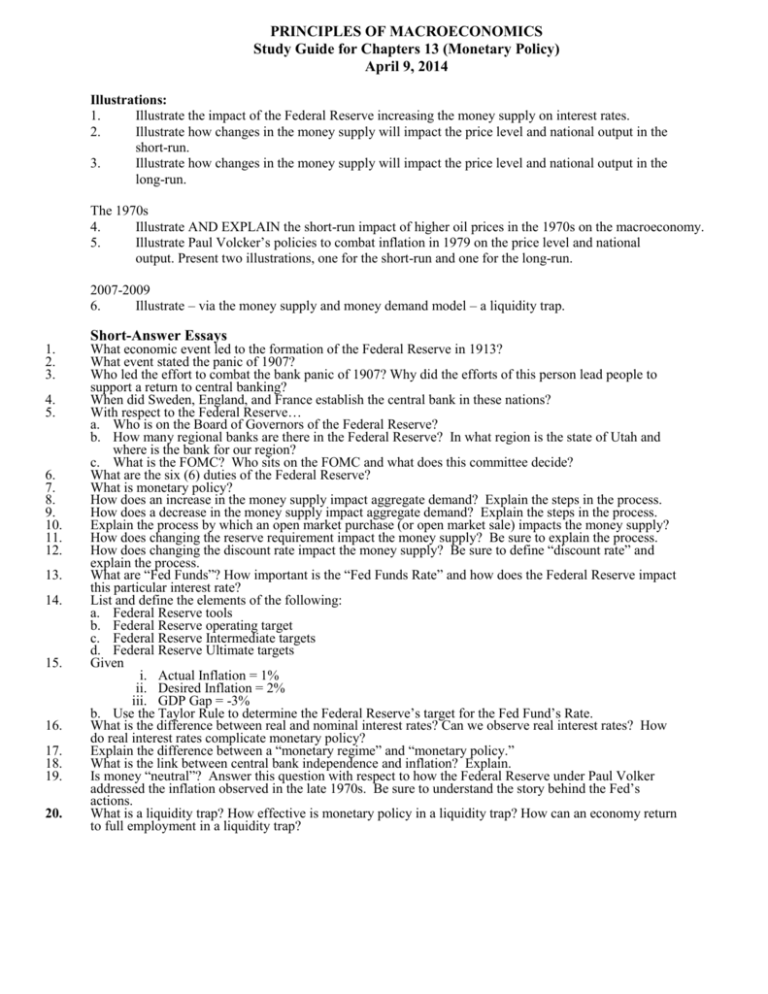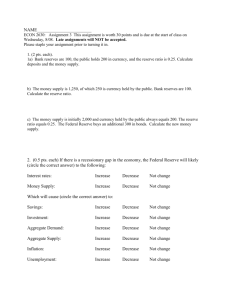Study Guide Ten
advertisement

PRINCIPLES OF MACROECONOMICS Study Guide for Chapters 13 (Monetary Policy) April 9, 2014 Illustrations: 1. Illustrate the impact of the Federal Reserve increasing the money supply on interest rates. 2. Illustrate how changes in the money supply will impact the price level and national output in the short-run. 3. Illustrate how changes in the money supply will impact the price level and national output in the long-run. The 1970s 4. Illustrate AND EXPLAIN the short-run impact of higher oil prices in the 1970s on the macroeconomy. 5. Illustrate Paul Volcker’s policies to combat inflation in 1979 on the price level and national output. Present two illustrations, one for the short-run and one for the long-run. 2007-2009 6. Illustrate – via the money supply and money demand model – a liquidity trap. Short-Answer Essays 1. 2. 3. 4. 5. 6. 7. 8. 9. 10. 11. 12. 13. 14. 15. 16. 17. 18. 19. 20. What economic event led to the formation of the Federal Reserve in 1913? What event stated the panic of 1907? Who led the effort to combat the bank panic of 1907? Why did the efforts of this person lead people to support a return to central banking? When did Sweden, England, and France establish the central bank in these nations? With respect to the Federal Reserve… a. Who is on the Board of Governors of the Federal Reserve? b. How many regional banks are there in the Federal Reserve? In what region is the state of Utah and where is the bank for our region? c. What is the FOMC? Who sits on the FOMC and what does this committee decide? What are the six (6) duties of the Federal Reserve? What is monetary policy? How does an increase in the money supply impact aggregate demand? Explain the steps in the process. How does a decrease in the money supply impact aggregate demand? Explain the steps in the process. Explain the process by which an open market purchase (or open market sale) impacts the money supply? How does changing the reserve requirement impact the money supply? Be sure to explain the process. How does changing the discount rate impact the money supply? Be sure to define “discount rate” and explain the process. What are “Fed Funds”? How important is the “Fed Funds Rate” and how does the Federal Reserve impact this particular interest rate? List and define the elements of the following: a. Federal Reserve tools b. Federal Reserve operating target c. Federal Reserve Intermediate targets d. Federal Reserve Ultimate targets Given i. Actual Inflation = 1% ii. Desired Inflation = 2% iii. GDP Gap = -3% b. Use the Taylor Rule to determine the Federal Reserve’s target for the Fed Fund’s Rate. What is the difference between real and nominal interest rates? Can we observe real interest rates? How do real interest rates complicate monetary policy? Explain the difference between a “monetary regime” and “monetary policy.” What is the link between central bank independence and inflation? Explain. Is money “neutral”? Answer this question with respect to how the Federal Reserve under Paul Volker addressed the inflation observed in the late 1970s. Be sure to understand the story behind the Fed’s actions. What is a liquidity trap? How effective is monetary policy in a liquidity trap? How can an economy return to full employment in a liquidity trap? MONETARY AND FISCAL POLICY IN THE GREAT DEPRESSION Given In 1930 we see approximately the following: Unemployment Rate = 8% Natural Rate of Unemployment = 6% Excess Unemployment = Unemployment Rate – Natural Rate of Unemployment = 8% - 6% = 2% Inflation = 3% Desired inflation = 2% Use Taylor’s Rule and Okun’s Law to answer the following questions: 1. Given the level of excess unemployment, how much would GDP decline (in percentage terms)? 2. Real GDP was approximately $800 billion before the Great Depression began. Given the answer to #1, what’s the new level of GDP? MONETARY POLICY 3. What does the Taylor Rule suggest the Fed Funds Rate should be? 4. Is your answer to #3 possible? a. Yes Remember, interest rates cannot be negative. b. 5. What does this tell us about the effectiveness of monetary policy? a. Won’t be effective. b. Will be effective. ___________ ______________ ______________ No FISCAL POLICY 6. Given the answer to #1&#2, if the multiplier is 2, how much would government spending have to increase to offset the decline in GDP (assuming no crowding out)? _______________________________________ 7. Prior to World War II government spending was typically less than 10% of GDP. What percentage of GDP (what GDP is after the downturn, not what it was before the downturn) is the government stimulus calculated in #6? 8. Given your answer to #7, is the size of stimulus calculated in #6 politically feasible in 1930? a. Yes b. No Answer questions 1-8 again but now use data from 1932: Given In 1932 we see approximately the following: Unemployment Rate = 20% Natural Rate of Unemployment = 5% Excess Unemployment = 15% (unemployment is 15% lower than it would be at full employment) Inflation = -10% NOTE: Inflation is a negative number (so we have deflation) Desired inflation = 2%









